Wednesday Mar. 21, 2007
We're at (or very close to) the Spring Equinox - the sun is rising in
the east and setting in the west, and days are 12 hours long.
Watch out if you walk across or if you're driving on an east-west
oriented street at sunrise or sunset.
The Experiment #2 revised reports were collected today. I'll try
to get them graded before the flood of Experiment #3 reports due next
Monday.
You might check to see if your name is on any of the lists on the class
home page.
We have a
lot of "odds and ends" type material to cover today and Friday.
One way of drying out moist air is to cool it below the dew
point.
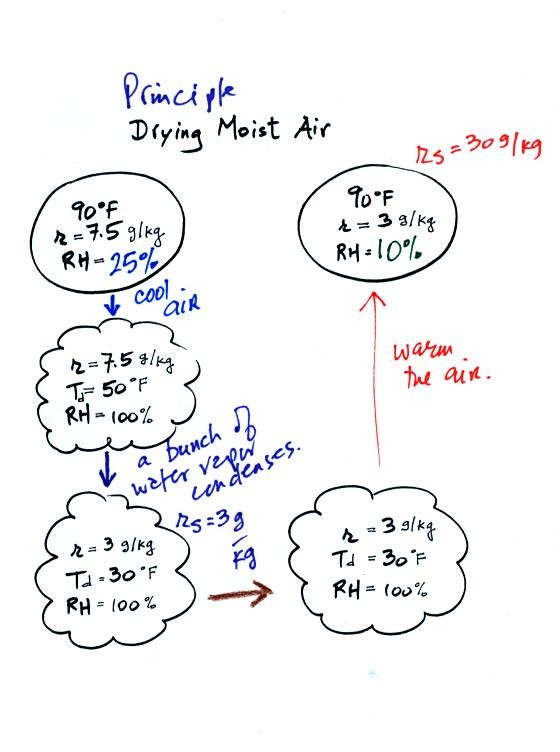
In the figure above the relative
humidity
reaches 100% when you cool moist 90 F air to 50 F, its dew point.
Then the air is cooled below the dew
point, to
30 F. The 30 F air can't hold the 7.5 g/kg of water vapor that
was originally found in the air. The excess moisture must
condense (we will assume it falls out of the air as rain or
snow). When air reaches 30 F it contains less than half the
moisture (3 g/kg) that it originally did (7.5 g/kg). Next the 30
F air is warmed back to 90 F, the starting temperature. The air
now
has a RH of only 10%.
Drying moist air is like wringing moisture from a wet sponge.
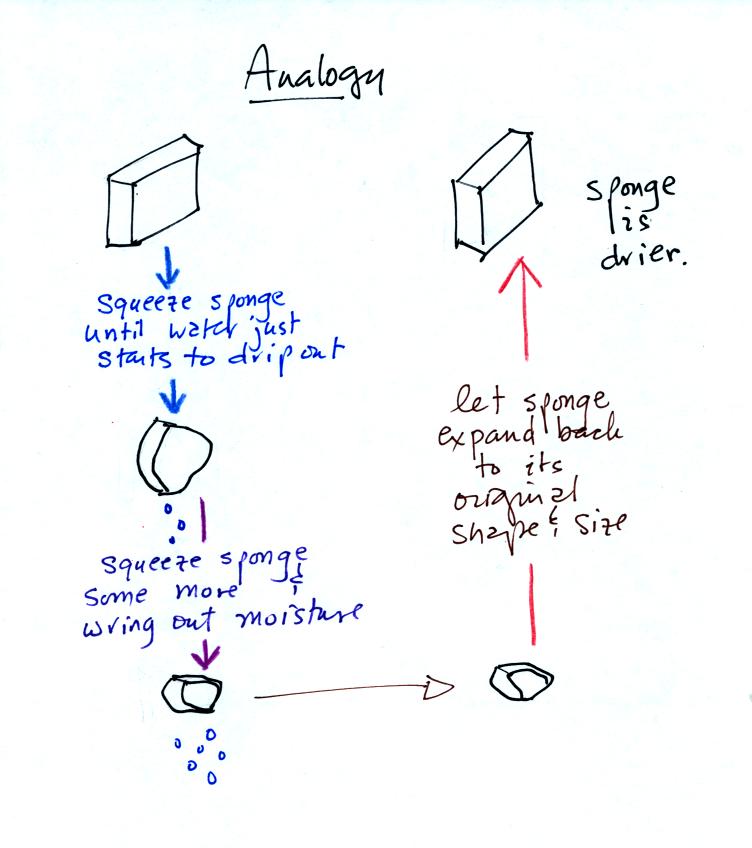
Cooling moist air below the dew point is kind of
like squeezing out or wringing out a wet sponge. You start to
squeeze the sponge and nothing happens at first (that's like cooling
the air, the mixing ratio stays constant as long as the air doesn't
lose any water vapor). Eventually water will start to drop from
the sponge (with air this is what happens when you reach the dew point
and continue to cool the air below the dew point). Then you let
go of the sponge and let it expand back
to its orignal shape and size (the air warms back to its original
temperature). The sponge (and the air) will be drier than when
you started.
This sort of process ("squeezing" water vapor out of moist air by
cooling the air below its dew point) happens all the time. Here
are a couple of examples.

In the
winter cold air is brought inside your house or apartment and
warmed. Imagine 30 F air with a RH of 100% being brought inside
and
warmed to 70 F. The RH will decrease to 20%. Indoors air
often has a very low relative humidity.
The air in an
airplane comes from outside the plane. The air outside the plane
can be very cold (-60 F perhaps) and contains very little water
vapor (even if the -60 F air is saturated it would contain essentially
no water vapor). When brought inside and warmed to a
comfortable
temperature the RH of the air in the plane will be very close 0%.
It is probably necessary for the ventilation system in the plane to add
moisture to the
air so that it doesn't get that dry.
Here's a very important example.
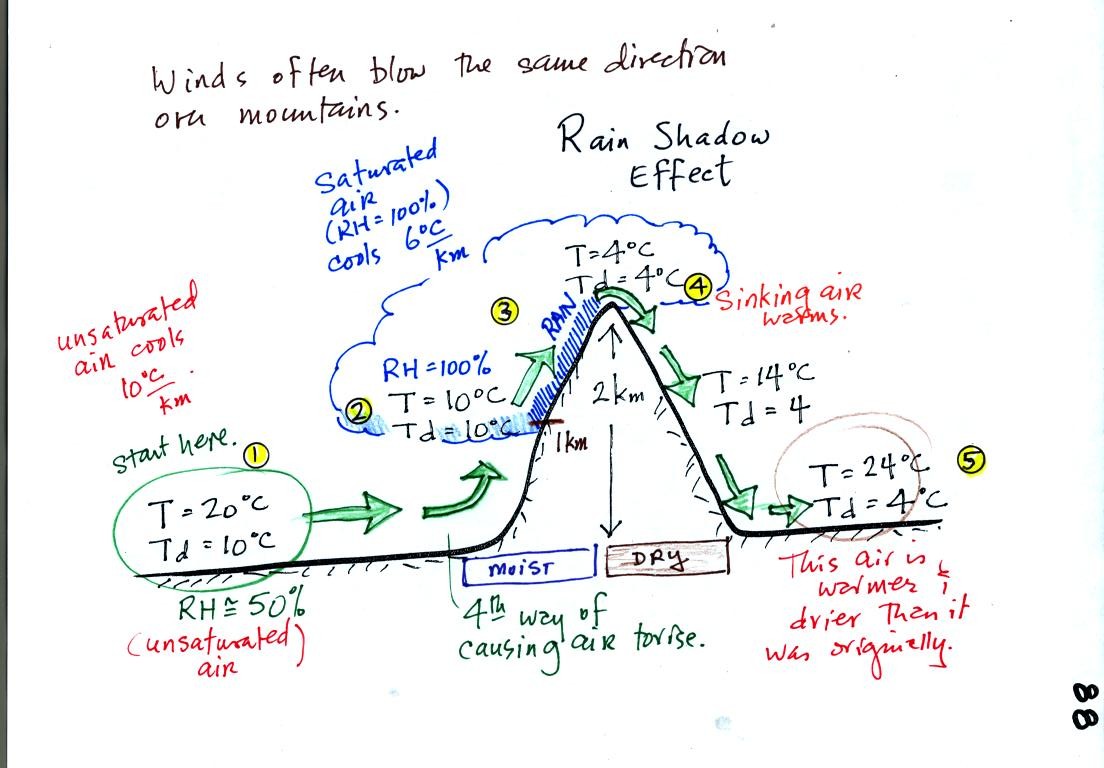
We start with some moist but unsaturated air (RH is about 50%) at Point
1 (the numbers were added after
class).
As it is moving toward the right the air runs into a mountain and
starts to rise (see the note below). Unsaturated air
cools 10 C for every kilometer of altitude gain.
This is known as the dry adiabatic lapse rate. So in rising 1 km
the air will cool to 10 C which is the dew point.
The air becomes saturated at Point 2, you would see a cloud
appear. Rising saturated air cools at a slower rate than
unsaturated air. We'll use a value of 6 C/km (an average
value). The air cools from 10 C to 4
C in next kilometer up to the top of the mountain. Because the
air is being cooled below its dew point at Point 3, some of the water
vapor will condense and fall to the ground as rain.
At Point 4 the air starts back down the right side of the
mountain. Sinking air warms. As soon as the air starts to
sink and warm, the relative humidity drops below 100% and the cloud
evaporates. The sinking air will warm at the 10 C/km rate.
At Point 5 the air ends up warmer (24 C vs 20 C) and drier (Td =
4 C vs Td = 10 C) than when it started out. The downwind side of
the mountain is referred to as a "rain shadow" because rain is less
likely there than on the upwind side of the mountain.
The air that arrives in Arizona comes from the Pacific Ocean. It
usually isn't very moist by the time it reaches Arizona because it has
travelled up and over the
Sierra Nevada mountains in
California and the Sierra Madre mountains further south in
Mexico. The air loses much of its moisture on the western slopes
of those mountains.
NOTE: The figure
above illustrates orographic or topographic lifting.
It is one of 4
ways of causing air to rise. The other three were: convergence
(surface winds spiral into centers of low pressure), convection (warm
air rises), and fronts.
Next we'll
learn about a simple instrument used to measure humidity, a sling
psychrometer.
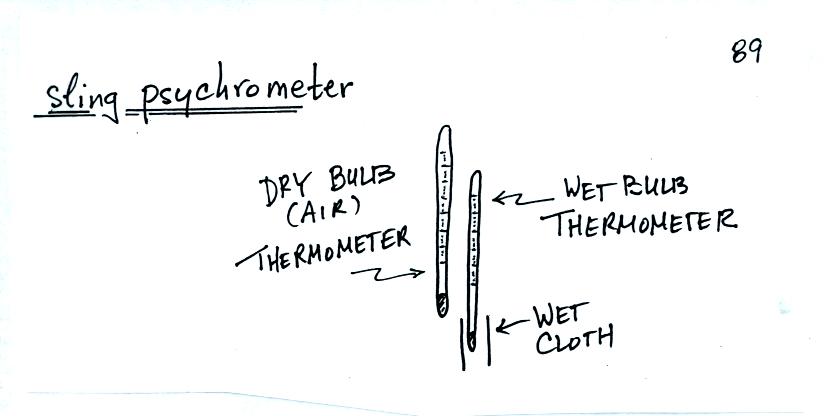
A sling
psychrometer consists of two thermometers mounted
side by side. One is an ordinary thermometer, the other is
covered with a wet piece of cloth. To
make a humidity measurement you swing the psychrometer around for a
minute or two and then read the temperatures from the two
thermometers. The following is an expanded and
enhanced version of the discussion in class.

The figure at upper left shows what
will happen as you start to swing the wet bulb thermometer. Water
will begin to evaporate from the wet piece of cloth. The amount
or rate of evaporation will depend on the air temperature (the 80 F
value was just made up in this example).
The evaporation is shown as blue arrows because this will cool the
thermometer. The same thing would happen if you were to step out
of a swimming pool on a warm dry day, you would feel cold. Swamp
coolers would work well on a day like this.
The figure at upper left also shows one arrow of condensation.
The amount or rate of condensation depends on how much water vapor is
in the air. In this case there isn't much water vapor. The
condensation arrow is orange because the condensation will release
latent heat and warm the thermometer.
Because there is more evaporation (4 arrows) than condensation (1
arrow) the wet bulb thermometer will drop.
Note in the bottom left figure we imagine that the wet bulb thermometer
has cooled to 60 F. Because the wet piece of cloth is cooler,
there is less evaporation. The thermometer will cool until the
rates of evaporation and condensation are in balance.
You
would measure a large difference between the dry and wet bulb
thermometers (20 F) on a day like this when the air is relatively dry.
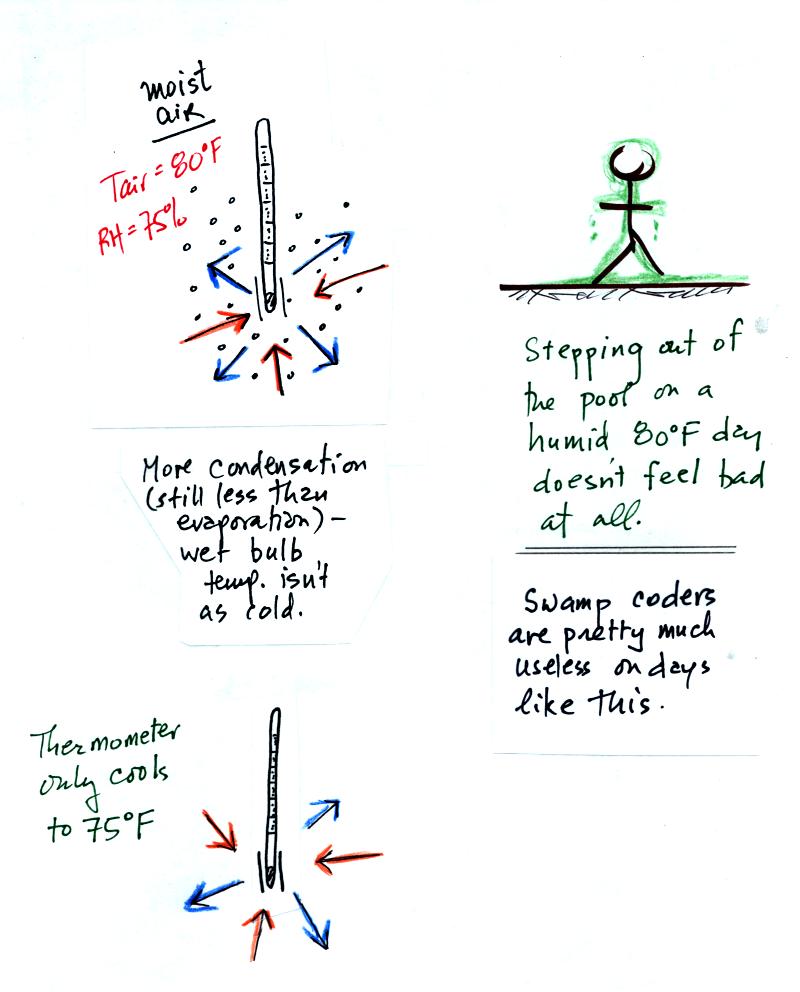
The air temperature is the same in this example, but there is more
water vapor in the air.
There are four arrows of evaporation and three arrows now of
condensation. The wet bulb thermometer will cool but won't get as
cold as in the previous example.
You wouldn't feel as cold if you stepped out of a pool on a warm humid
day like this. Swamp coolers wouldn't provide much cooling on a
day like this.
The wet bulb thermometer might well only cool to 75 F. This might
be enough to lower the rate of evaporation enough to bring it into
balance with the rate of condensation.
You would measure a small difference (5 F) between the dry and wet bulb
thermometers on a humid day like this.
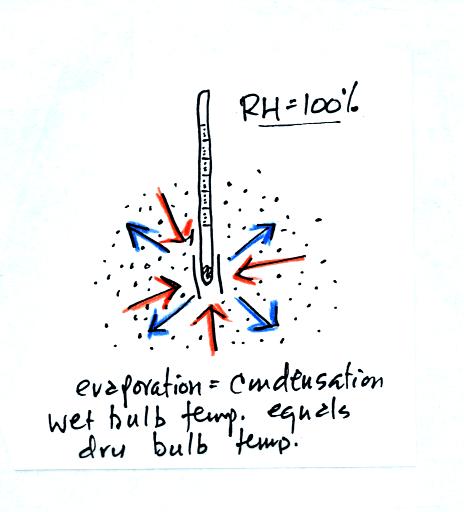
There won't be any difference in
the dry and wet bulb temperatures when
the
RH=100%.
When you
cool air that is next to the ground to the dew point, water
vapor condenses onto objects on the ground such as blades of grass,
your automobile, your morning newspaper.
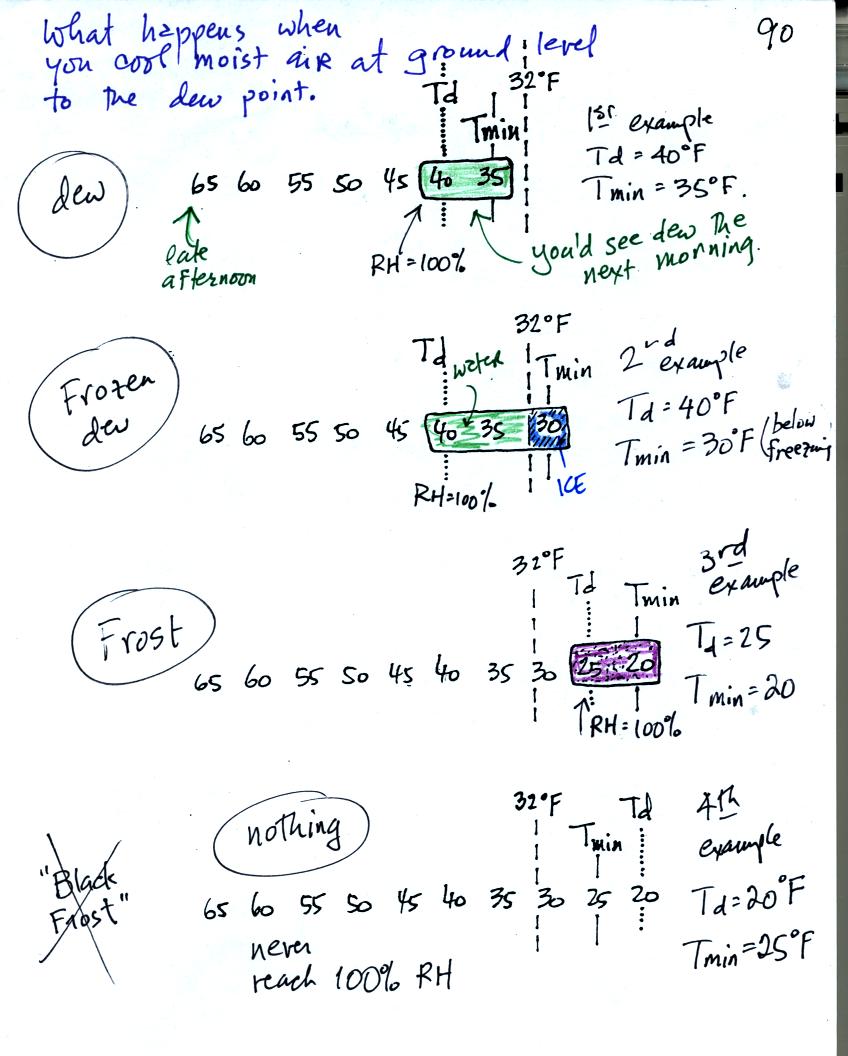
In the first example air starts out with a
temperature
of 65 F early in the evening. It cools to 35 F during the
night. When the air reaches 40 F, the
dew point, the RH reaches 100%. As the air temperature drops
below the dew point and cools to 35 F water vapor will condense onto
the ground or objects on the ground (such as an automobile). This
is dew.
The dew point is the same but the nighttime minimum temperature
is below freezing in the second example. Dew will form again on
this night when the
air temperature reaches 40 F. Once the air temperature drops
below 32 F though the dew will freeze and form frozen dew.
In the third example both the dew point and nighttime minimum
temperatures are below freezing. When the air temperature drops
below the dew point, water vapor turns directly to ice (deposition) and
forms frost.
The dew point in this case is sometimes called the frost point.
The air never becomes saturated in the fourth example because the
nighttime minimum temperature never cools to the dew point. You
wouldn't see anything on this night.
When air
above the ground reaches 100% relative humidity it is much easier for
water vapor to condense onto small particles in the air called
condensation nuclei than to just form a small droplet of water.
There are hundreds even thousands of these small particles in every
cubic centimeter of air. We can't see them because they are so
small.
You can learn why it is so hard to form small droplets of pure water by
reading p. 92 in the photocopied class notes.

Water vapor will condense onto certain kinds of condensation
nuclei
even when the relative humidity is below 100% (again you will find some
explanation of this on p. 92). These are called hygroscopic
nuclei.









